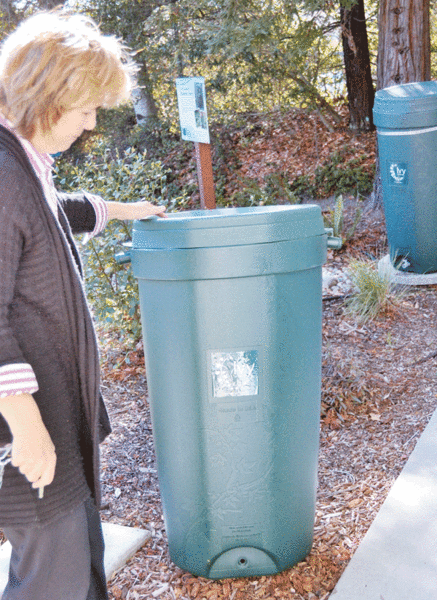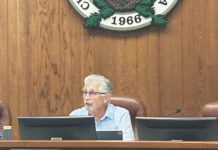Faced with looming statewide droughts due to lack of significant rainfall, some Santa Cruz County residents, water districts, and nonprofit organizations are turning to rainwater harvesting as a means of maximizing the uses of what little rain actually has come through.
Ranging in scale from simple barrels positioned beneath downspouts to complex underground irrigation systems, harvesting rainwater can simultaneously reduce the amount of water wasted down storm drains, lighten demands on potable water, and help recharge subterranean aquifers.
LeAnne Ravinale, water conservation coordinator with the Scotts Valley Water District, said that outdoor water usage, such as landscaping and lawns, accounts for more than half of all potable water usage in the district’s coverage area — about 74 gallons per person, per day.
A large step toward reducing that daily total to somewhere around 35 gallons per person, per day, she said, could be achieved by collecting rainwater that falls on the roofs of buildings, and irrigating water that hits the ground away from impermeable surfaces and storm drains and to where it can saturate the soil.
“For a 1,000 square-foot house, one inch of rain means 600 gallons of water,” said Ravinale.
Since 2012, she said, the district has sold approximately 150 small, 50-gallon rain barrels at a discount to its customers, as well as offered a 25-cent-per-gallon rebate on rainwater collection tanks, as an incentive to reduce potable water usage.
“We think that (the rain barrels are) very educational for people,” Ravinale said. “It fills up very quickly and it empties very quickly — it really opens people’s eyes to how much water they’re using.”
She said that irrigating harvested water away from storm drains and into soil — ideally via soil depressions covered in permeable material such as wood chips — helps reduce the strain on the aquifer that supplies much of Scotts Valley’s water.
“Every one of our homes and businesses needs to be a recharge system,” Ravinale said. “Don’t let the water run off your property.”
The district is also partnering with the Santa Cruz-based nonprofit Ecology Action to not only promote rainwater harvesting, but to explore even further ways to expand awareness.
Sherry Bryan, senior program specialist with Ecology Action, said that the organization will offer rebates on rainwater tanks, lawn removal or turf replacement, runoff redirection, and replacement of impervious surfaces with permeable ones.
The rebates, she said, would likely be launched in March or April, and would augment many of those already offered by the water district.
“Scotts Valley is a big focus,” Bryan said, “because it’s a major groundwater recharge area.”
James Mueller, general manager for the San Lorenzo Valley Water District, said that the district was not currently offering rebates for rainwater catchment systems. But, as the drought continues, he said, it was an option the district’s board of directors would likely consider.
Bryan said that Ecology Action was in the process of distributing six $10,000 grants received from state Proposition 84 funds to residents of the Monterey Bay Area to test the reliability and feasibility of utilizing rainwater catchment systems to provide water for nonpotable indoor usage — such as toilets and laundry machines.
Bryan said that in the long run, outdoor rain harvesting systems would likely not hold enough water to keep a garden, lawn, or landscape watered over the course of the dry, summer months. Rather, she said, it made more sense to collect rainwater for indoor usage during the wet, rainy months.
“We’re using perfectly clean drinking water to flush toilets,” Bryan said.
She said that those who applied for the grant would serve as part of a yearlong trial of the indoor systems, which would filter the collected water to safe levels before distributing it to the indoor appliances, to raise awareness with customers and water district staff alike.
“California plumbing code just changed allowing rainwater to be used for indoor non-potable uses,” Bryan said. “We’re working with all the jurisdictions that issue building permits to familiarize their staff with the systems and to develop smooth permitting processes.”
Scotts Valley resident Jo Fleming was one of the applicants for the grants.
She said that, as an environmental scientist, she was interested not only to see how much water the system would save, but also as the first step in adopting a more eco-friendly approach to her water use.
“I think it’d be fun,” Fleming said. “The next step is the water step for me.”
She said that she felt it was important to irrigate outdoors “since we’re all groundwater here in Scotts Valley and that water is being rapidly depleted.”
For more information, visit www.ecoact.org or http://www.svwd.org/
– To comment, email reporter Joe Shreve at jo*@*********er.com, call 438-2500 or post a comment at www.pressbanner.com.












